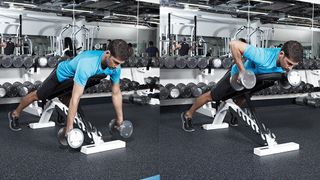How To Do The Incline Bench Row
The chest-supported row allows you to lift heavier and perfect your rowing form

If you’re looking to strengthen and build muscle in your back, then prepare to perform a lot of exercises with the word “row” in them. Thankfully, there are no shortage of types of row to choose from, with the bent-over row being perhaps the most fundamental.
The incline bench row is a terrific variation to add to your workout repertoire for several reasons. By supporting your chest with a bench during the move, you remove the instability that is part of the standing bent-over row. This means you can focus more on your form and home in on the back muscles you’re looking to target with the move, and it also allows you to lift heavier weights because you are in that safer, supported position.
It’s not all good news, though. By removing the instability of a standing row you lose some of the core-strengthening benefits of the row, but this is a move mainly designed to work the back muscles, and the incline bench row does a fantastic job on that front.
See related
- The Best Back Exercises For All Levels Of Gym-Goer
- Back Workouts To Build A Broader, Stronger Back
- Use This Back Workout At Home To Improve Your Posture
How To Do The Incline Bench Row
Set up a bench at a 45° angle and lie face down on it so your chest is in full contact with the bench with your feet on the floor behind you. Let your arms hang down, holding a set of dumbbells with your palms facing each other.
Row the weights up by squeezing your shoulder blades together and bringing your elbows back until your upper arms are level with or slightly higher than your torso. Slowly lower the weights back to the start.
While the bench is supporting you during the exercise, that doesn’t mean you don’t need to be conscious of your body position. Focus on keeping your chest and abs pressed into the bench – in particular, don’t let your lower back arch away from the bench. This will ensure the exercise isolates the back muscles and stops you creating momentum to assist the lift.
Get the Coach Newsletter
Sign up for workout ideas, training advice, reviews of the latest gear and more.

Nick Harris-Fry is a journalist who has been covering health and fitness since 2015. Nick is an avid runner, covering 70-110km a week, which gives him ample opportunity to test a wide range of running shoes and running gear. He is also the chief tester for fitness trackers and running watches, treadmills and exercise bikes, and workout headphones.
